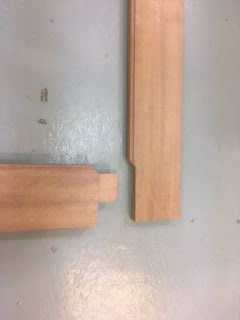First a rabbet was planed for receiving the glass (which is not real glass by the way), and next a small beading was planed on the front side.
The door frame was assembled with short tenons (1.25" long), and the beading was made continuous by mitering the corners of the beading /rabbet portion of the parts.
I removed the glass form the old door and adjusted its size so it would fit the new door.
The glass was mounted by means of some Sikaflex and 12 small screws that were driven in at an angle, so the head would press the glass down into the rabbet. Not exactly high end furniture style, but OK for this application.
A bit of the Siaflex oozed out, but given that the glass is plastic, I don't want to risk destroying it by being too eager with a chisel when scraping it off.
The two door latches were then mounted by chiseling out a recess, so I could attach the nut from the backside. They are not designed to be used on stuff much thicker than 1/4", so I had to remove some material from the front and the back.
Finally the door was mounted using the reclaimed hinges, and the door latches were adjusted so they could keep the door closed.
I have applied one coat of varnish to the door and the face frame, and as soon as it has dried, I plan to give it another coat, I think that will be sufficient, though the common rule of thumb according to boat varnishing in Denmark states that you should apply 7 layers of varnish with a light sanding in between. This is probably a rule of thumb that has been invented by the manufacturers of varnish!
New door, with first coat of varnish.
New door prior to varnishing.
Short tenons
Beading detail (and ugly mark from the clamp)
Face frame mounted.
Latch for the door.






Neat! It looks really great. The finish looks fine. Do you expect it will hold up to the weather?
ReplyDeleteHi Brian
DeleteI think it will hold up pretty good to the weather. The cabinet is on the aft part of the accommodation, so it isn't the most vulnerable position on the boat.
I can always give it another coat next time I get back on board.
Brgds
Jonas
Now everyone is going to want nice wood cabinet doors on their ships. Trendsetting again. I like how you added a molding around the inside of the frame and mitered it, very nice touch.
ReplyDeleteHi Jeff
DeleteThanks for the nice comment.
It does look a bit flashy compared to the normal standard on PSV's (Platform Supply Vessel's), but a little bit of showing off never hurt anyone.
I am glad that you like the small beading detail, I first tried it on the pilot ladder cabinet, and I was so impressed with the results that I had to try it again. It does require a bit of extra work, but it looks so good that I think the investment is well worth it.
Brgds
Jonas
Transforming a PSV in a RIVA boat...
ReplyDeleteSylvain
Hi Sylvain
DeleteThanks for the very nice comment.
But that is a bit of an overstatement :-)
A Riva is truly a work of art, but I agree that it gives a touch of class to this ship.
Brgds
Jonas
Nice work.
ReplyDeleteThanks Jeremy
DeleteIt is nice to make a project that will be proudly on display once in a while.
Brgds
Jonas
My father-in-law was a scavenger and, in the seventies he went around to get the shipping crates that Japanese motorcycles came in. I inherited a pile of this lumber and made a lot of patio furniture from it. Other than a coat of tung oil when I first made it, it has never received finish and yet it still looks good two decades later. When I saw your door, I recognized the wood immediately as the same. Whatever it is, it weathers extremely well.
ReplyDeleteHi Andy
DeleteThanks for the comment.
Do you have any idea of the name of the wood? I have been asked several times by the other crew members, but I have absolutely no idea what it is.
I am pretty sure that today the shipping crates are most likely made of laminated veneer lumber and plywood. Not the sort of thing that you would be able to build nice furniture out of.
I wasn't sure of how weatherproof it was, so that is shy I gave it two coats of varnish.
Best regards
Jonas
I have no idea what it is and have always wondered.
Delete